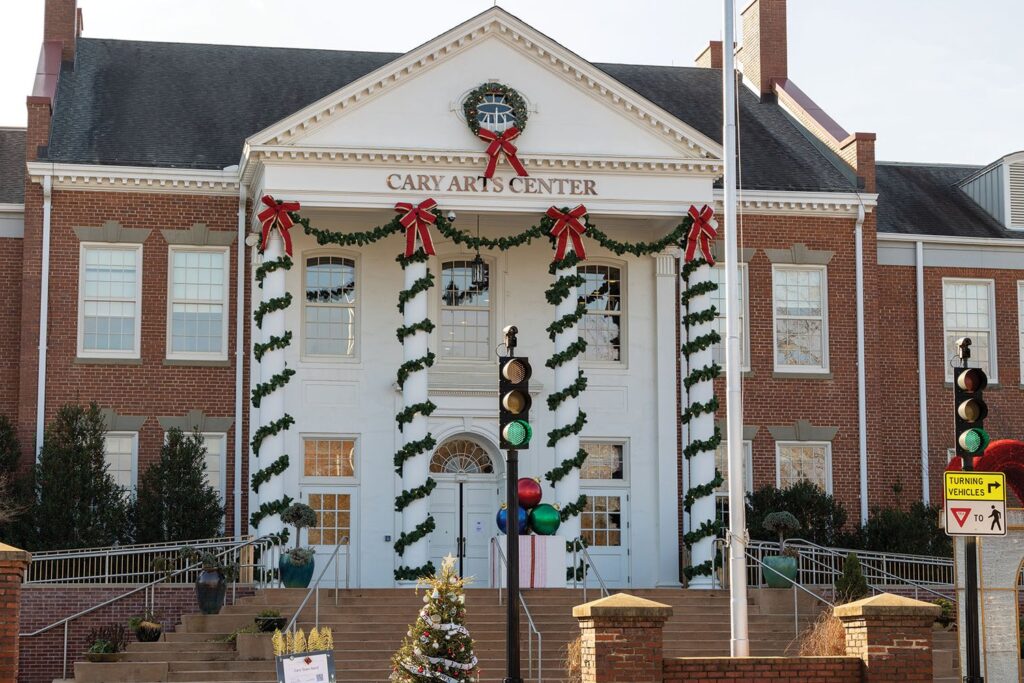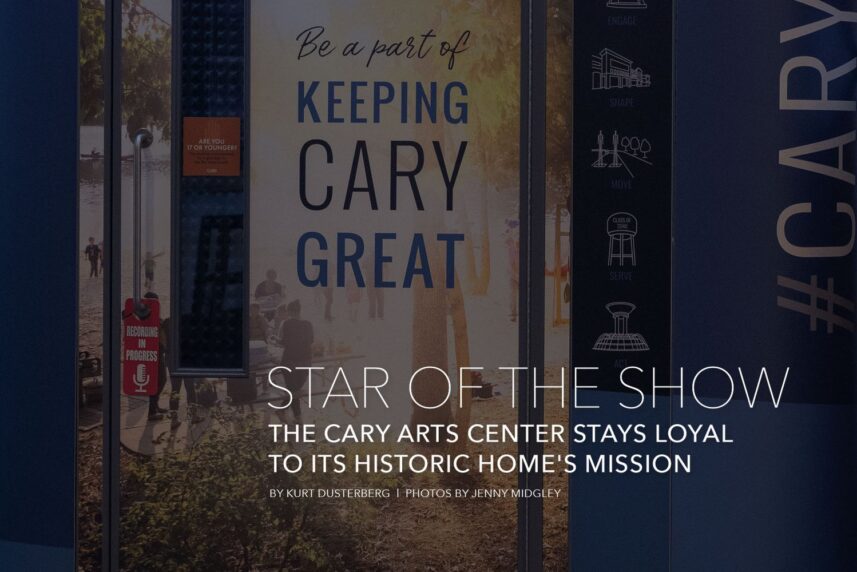Article:
For more than 80 years, the building that now accommodates the Cary Arts Center has starred as a visual centerpiece in Cary, rising prominently over the end of Academy Street on Dry Avenue. With its neoclassical architecture, it has served the purposes of education and the arts with a certain dignity.
When the school building gave way to the cultural arts in 2010, the Town of Cary set out to maximize its offerings for local residents. Want to take a class? Catch a show? Either way, the Cary Arts Center has you covered. “That came about from purposeful planning,” says Robbie Stone, Cary’s arts program and operations coordinator. “When a town builds a facility, it’s going to lean one way or another. It’s going to be performing arts, or it’s going to be fine arts—visual and craft. What we wanted to do was incorporate all of that under one roof.”
Much of Cary’s history has played out under the roof of this two-story, red brick building. Constructed in 1938 by the Works Progress Administration, it served as Cary High School until 1961, when it became Cary Junior High and Elementary School. The town purchased the property in 2010, and it has thrived ever since.
Funded by the Town of Cary, the Cary Arts Center’s fine arts education program employs more than 80 part-time experienced instructors, catering to adults and children alike. “We’re very fortunate in this area that we have a population that is looking for entertainment and diversion and enrichment,” Stone says. “So we get the word out and they respond. We’re just lucky in that way.”
Open for Art
Sarah Clover is a Raleigh artist who started teaching beginner classes in the glass studio last July. “I encourage people in their creativity of how to make their ideas happen,” Clover says. “But glass can be technical, so you’ve got to learn a lot about how it works, how it fuses.”
The arts center also caters to more established artists—those who benefit from the tools and supplies available in the art rooms. “We have open studios,” she says. “Some are very advanced, but it’s social. The people who come here—some have kilns and they do stuff at home—but they come in and work together and bounce ideas off each other.”
David Tomlin manages the metal studio, where locals come to make jewelry. In addition to training in jewelry and metal art, he is an experienced gem cutter, which helped him start a lapidary program. “I can teach as much as I know,” says Tomlin, who is semi-retired. “It’s a skill. The more you do, the better you get. The biggest problem for most of us is the creativity of design. What is it you want to do? And if you know, we can usually figure out a way to do it. It’s nice to be surrounded by each other, because we do feed off one another.”
A walk along the second-floor hallway reveals that one arts discipline stands out from the rest. “Our clay program is our most popular,” Stone says. “It’s also very popular with our open studio users. They don’t want to purchase a wheel and a kiln. They can come in and use ours.”
On Stage
Performing arts also make up a staple of the Cary Arts Center. Applause! Cary Youth Theatre stages its productions without adults. There are dedicated areas for rehearsals and set designs, along with dressing rooms and a green room. The award-winning troupe performs in the center’s 431-seat theater. “The kids can come in and take acting classes,” Stone says. “They can learn to do designs for stage work. They can work in the costume shop.”
Residents interested in watching professional performances can choose from multiple options. The Marvelous Music series attracts lesser-known niche artists who are selected from showcase events to match the taste of local patrons. The Concert Singers of Cary comprise the Symphonic Choir, the Chamber Choir and the Chorale. Other perfomers include the Cary Town Band, Oak City Sound, Philharmonic Youth Orchestra, Cary Players and Cary Ballet Conservatory, to name a few.
Reverence to the Past
Like so many spaces in the building, the theater has a story to tell. It served Cary High School throughout its existence, but the echoes of performances past became memories when Cary Elementary converted the space into a library. The Cary Arts Center restored it to its original use, and the theater roared back to life. “[Cary Elementary] had leveled the floor, but we took it back to a theater space,” Stone says. “Also, the stage used to be very shallow. We tore down the back wall and pushed it back several yards. We created what is known as a fly tower—the area where all the stage rigging lives up above.”
History may not ooze from these walls, but it certainly hangs on them. Along the first-floor walls hang senior-class montage photos, including one from 1913. Those Cary High School students were educated in a four-room wooden structure on the same site. That year, Cary citizens approved $25,000 in bonds for a 33-room brick structure, which preceded the current building. Other reminders of years past are sprinkled throughout the first floor. Principal’s Hall, the original principal’s office, serves as an art gallery and conference room with the original hardwood floors intact. Old locker doors serve as wainscoting, while glass display cases preserve classroom clocks, exit signs and school bells. “We wanted to give a nod to the history of the building,” Stone says.
These gestures to the past are a fitting thread that ties Cary’s old commercial core to its future. The new Cary Regional Library opened in 2019, and the adjacent Downtown Cary Park will debut in 2023, keeping the revered old building front and center. “One of the reasons the town invested so heavily in the arts center and the downtown park is for economic development,” Stone says. “It was their vision that this part of town had the potential to really be vital—to be cutting edge and to provide lots of services to the citizens of Cary.”



